Evaluating Employee Engagement Practices and Motivation at John Lewis
VerifiedAdded on 2023/01/03
|10
|1515
|74
Report
AI Summary
This research report explores the impact of employee engagement practices on employee motivation, focusing on John Lewis and Partners. The study aims to evaluate these practices, analyze the concepts of employee motivation and engagement, and provide recommendations for improvement. The research employs a qualitative approach, collecting primary data through interviews with 30 employees at John Lewis locations in London, using purposive sampling. Secondary data will be collected through books, online sources, and literature journals. Data analysis will be conducted using narrative analysis, and ethical considerations such as informed consent, privacy, and data security are addressed. The report includes a project plan outlining the research timeline and a risk register identifying potential challenges. The findings are presented in a structured format, including a literature review, research methodology, data analysis, and recommendations, contributing to a deeper understanding of employee engagement and motivation within the organization.

Talent Management
Paraphrase This Document
Need a fresh take? Get an instant paraphrase of this document with our AI Paraphraser
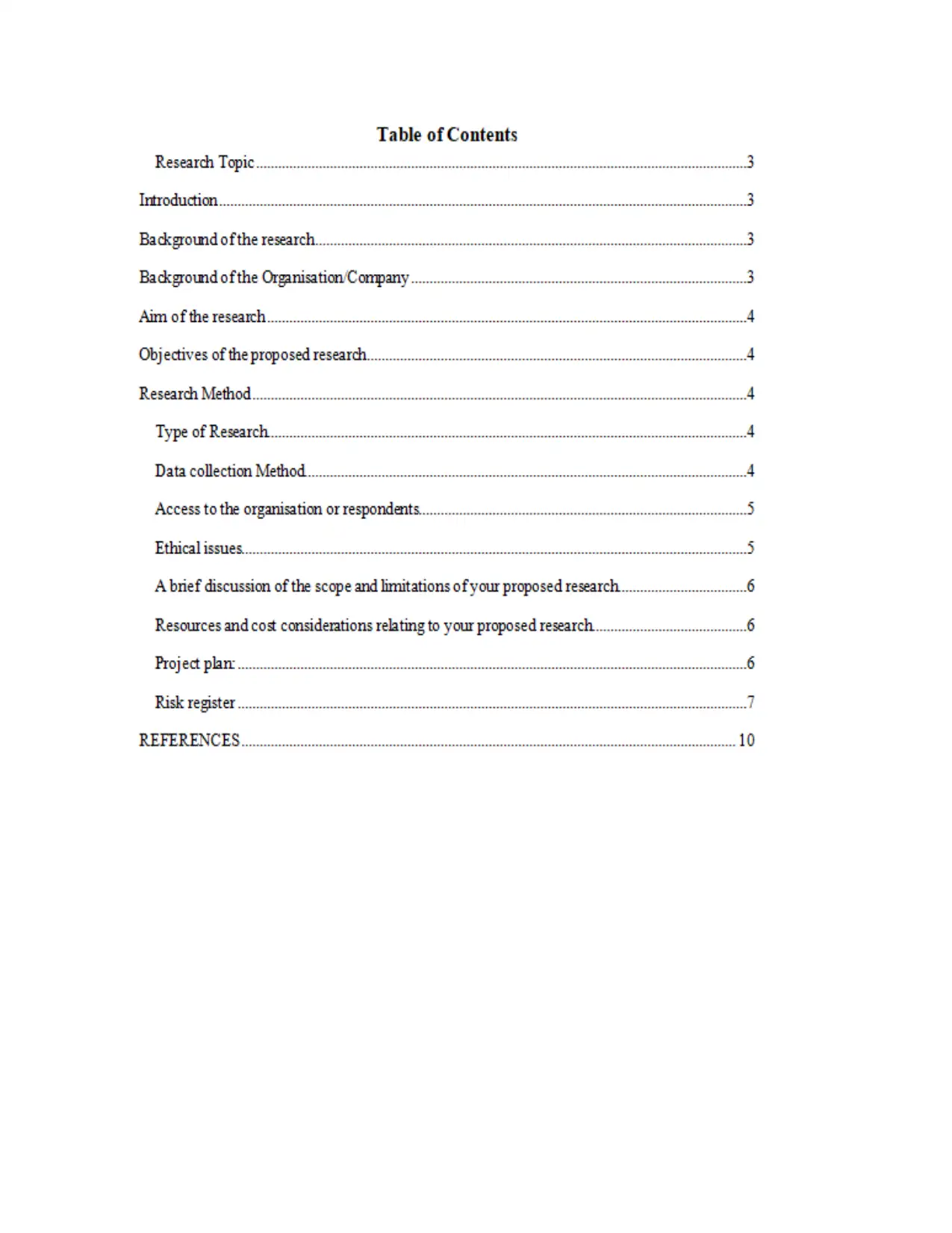
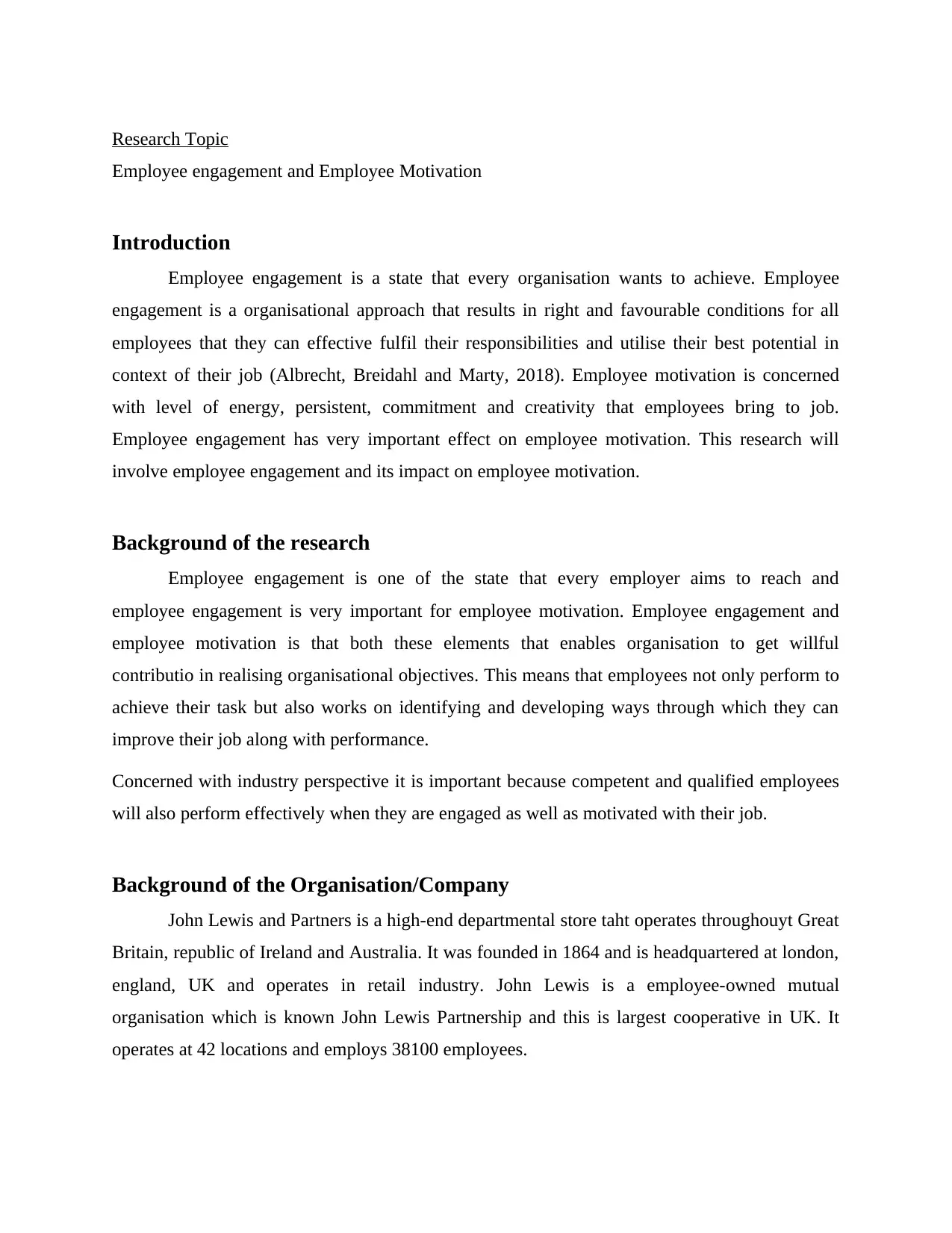
Research Topic
Employee engagement and Employee Motivation
Introduction
Employee engagement is a state that every organisation wants to achieve. Employee
engagement is a organisational approach that results in right and favourable conditions for all
employees that they can effective fulfil their responsibilities and utilise their best potential in
context of their job (Albrecht, Breidahl and Marty, 2018). Employee motivation is concerned
with level of energy, persistent, commitment and creativity that employees bring to job.
Employee engagement has very important effect on employee motivation. This research will
involve employee engagement and its impact on employee motivation.
Background of the research
Employee engagement is one of the state that every employer aims to reach and
employee engagement is very important for employee motivation. Employee engagement and
employee motivation is that both these elements that enables organisation to get willful
contributio in realising organisational objectives. This means that employees not only perform to
achieve their task but also works on identifying and developing ways through which they can
improve their job along with performance.
Concerned with industry perspective it is important because competent and qualified employees
will also perform effectively when they are engaged as well as motivated with their job.
Background of the Organisation/Company
John Lewis and Partners is a high-end departmental store taht operates throughouyt Great
Britain, republic of Ireland and Australia. It was founded in 1864 and is headquartered at london,
england, UK and operates in retail industry. John Lewis is a employee-owned mutual
organisation which is known John Lewis Partnership and this is largest cooperative in UK. It
operates at 42 locations and employs 38100 employees.
Employee engagement and Employee Motivation
Introduction
Employee engagement is a state that every organisation wants to achieve. Employee
engagement is a organisational approach that results in right and favourable conditions for all
employees that they can effective fulfil their responsibilities and utilise their best potential in
context of their job (Albrecht, Breidahl and Marty, 2018). Employee motivation is concerned
with level of energy, persistent, commitment and creativity that employees bring to job.
Employee engagement has very important effect on employee motivation. This research will
involve employee engagement and its impact on employee motivation.
Background of the research
Employee engagement is one of the state that every employer aims to reach and
employee engagement is very important for employee motivation. Employee engagement and
employee motivation is that both these elements that enables organisation to get willful
contributio in realising organisational objectives. This means that employees not only perform to
achieve their task but also works on identifying and developing ways through which they can
improve their job along with performance.
Concerned with industry perspective it is important because competent and qualified employees
will also perform effectively when they are engaged as well as motivated with their job.
Background of the Organisation/Company
John Lewis and Partners is a high-end departmental store taht operates throughouyt Great
Britain, republic of Ireland and Australia. It was founded in 1864 and is headquartered at london,
england, UK and operates in retail industry. John Lewis is a employee-owned mutual
organisation which is known John Lewis Partnership and this is largest cooperative in UK. It
operates at 42 locations and employs 38100 employees.
⊘ This is a preview!⊘
Do you want full access?
Subscribe today to unlock all pages.

Trusted by 1+ million students worldwide
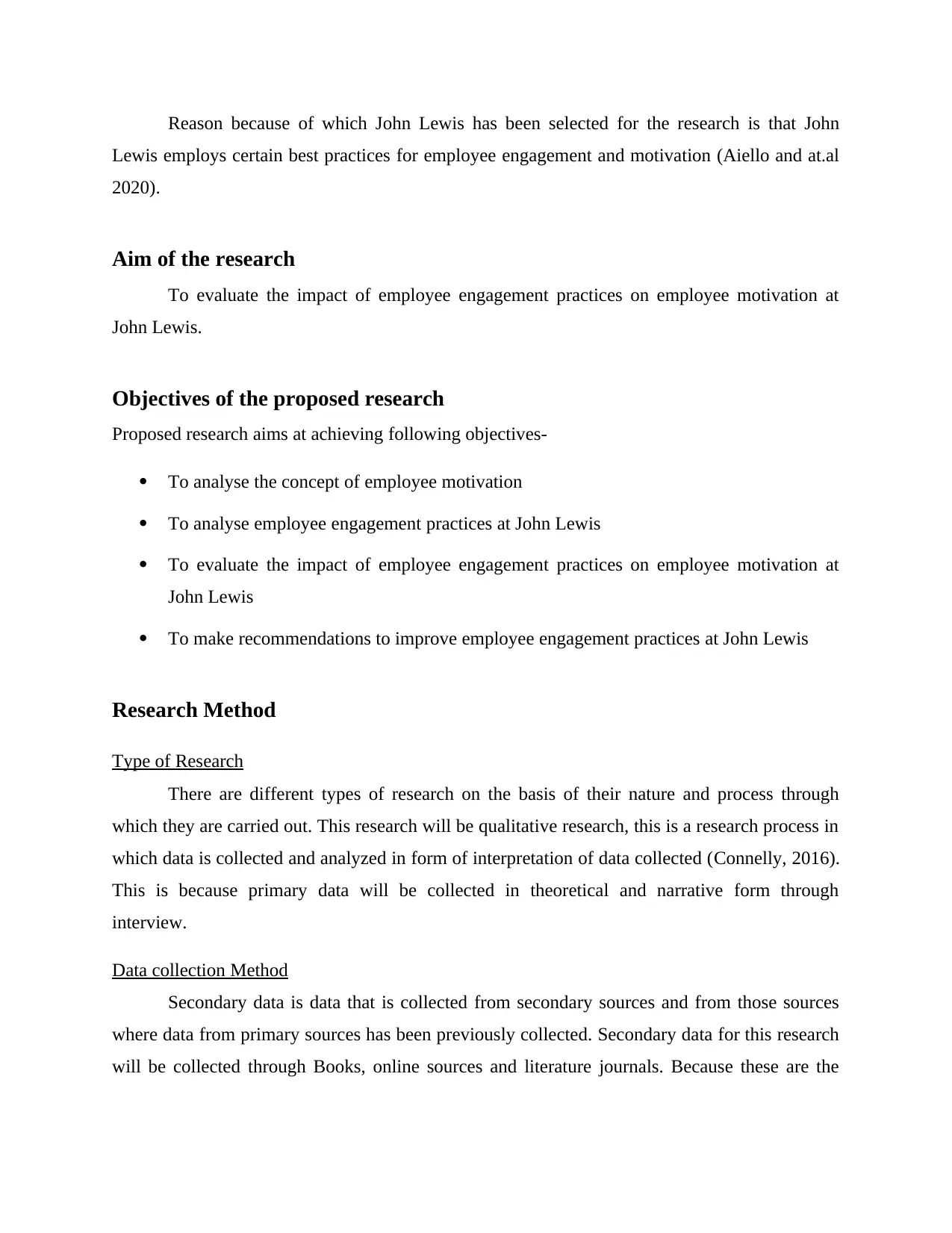
Reason because of which John Lewis has been selected for the research is that John
Lewis employs certain best practices for employee engagement and motivation (Aiello and at.al
2020).
Aim of the research
To evaluate the impact of employee engagement practices on employee motivation at
John Lewis.
Objectives of the proposed research
Proposed research aims at achieving following objectives-
To analyse the concept of employee motivation
To analyse employee engagement practices at John Lewis
To evaluate the impact of employee engagement practices on employee motivation at
John Lewis
To make recommendations to improve employee engagement practices at John Lewis
Research Method
Type of Research
There are different types of research on the basis of their nature and process through
which they are carried out. This research will be qualitative research, this is a research process in
which data is collected and analyzed in form of interpretation of data collected (Connelly, 2016).
This is because primary data will be collected in theoretical and narrative form through
interview.
Data collection Method
Secondary data is data that is collected from secondary sources and from those sources
where data from primary sources has been previously collected. Secondary data for this research
will be collected through Books, online sources and literature journals. Because these are the
Lewis employs certain best practices for employee engagement and motivation (Aiello and at.al
2020).
Aim of the research
To evaluate the impact of employee engagement practices on employee motivation at
John Lewis.
Objectives of the proposed research
Proposed research aims at achieving following objectives-
To analyse the concept of employee motivation
To analyse employee engagement practices at John Lewis
To evaluate the impact of employee engagement practices on employee motivation at
John Lewis
To make recommendations to improve employee engagement practices at John Lewis
Research Method
Type of Research
There are different types of research on the basis of their nature and process through
which they are carried out. This research will be qualitative research, this is a research process in
which data is collected and analyzed in form of interpretation of data collected (Connelly, 2016).
This is because primary data will be collected in theoretical and narrative form through
interview.
Data collection Method
Secondary data is data that is collected from secondary sources and from those sources
where data from primary sources has been previously collected. Secondary data for this research
will be collected through Books, online sources and literature journals. Because these are the
Paraphrase This Document
Need a fresh take? Get an instant paraphrase of this document with our AI Paraphraser
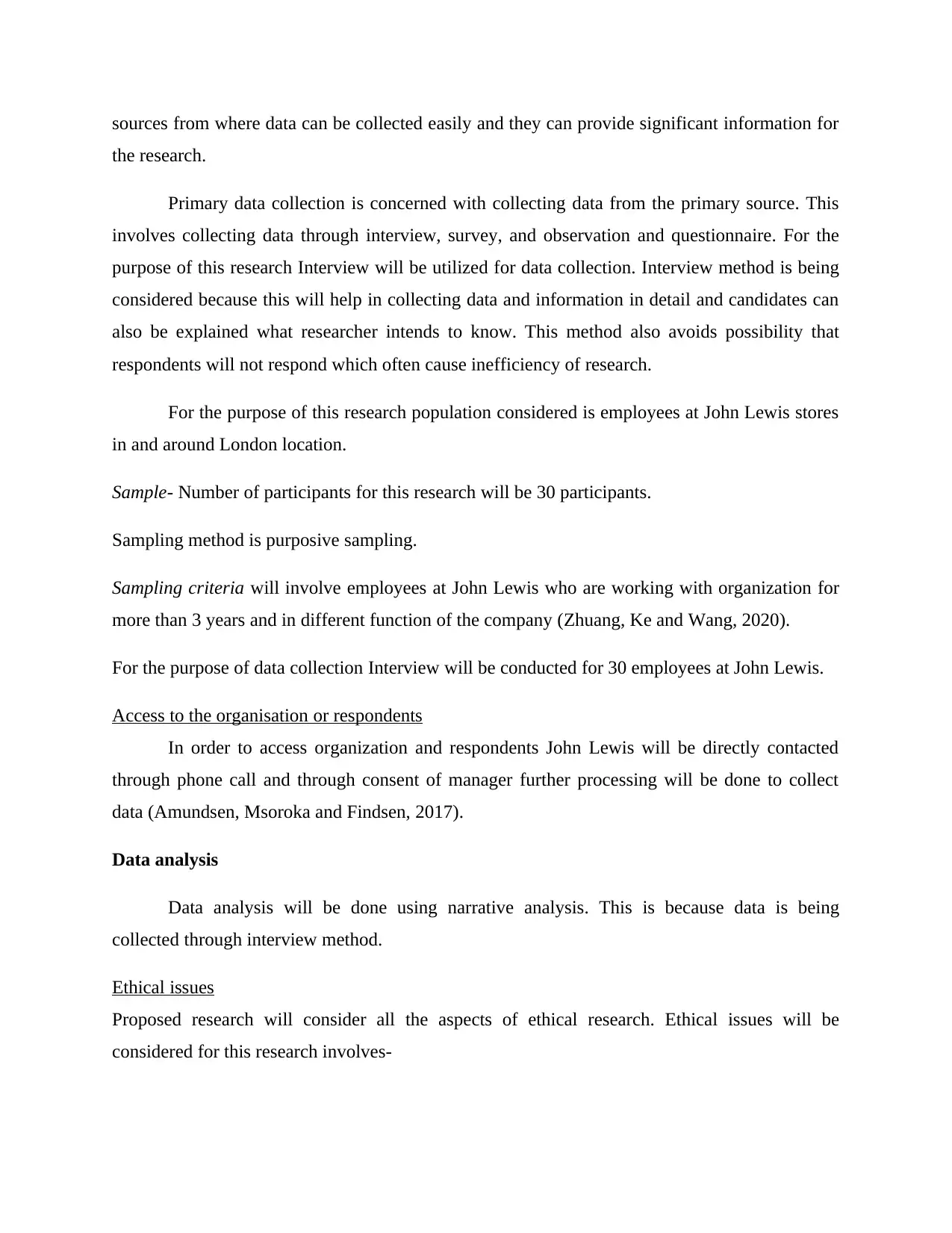
sources from where data can be collected easily and they can provide significant information for
the research.
Primary data collection is concerned with collecting data from the primary source. This
involves collecting data through interview, survey, and observation and questionnaire. For the
purpose of this research Interview will be utilized for data collection. Interview method is being
considered because this will help in collecting data and information in detail and candidates can
also be explained what researcher intends to know. This method also avoids possibility that
respondents will not respond which often cause inefficiency of research.
For the purpose of this research population considered is employees at John Lewis stores
in and around London location.
Sample- Number of participants for this research will be 30 participants.
Sampling method is purposive sampling.
Sampling criteria will involve employees at John Lewis who are working with organization for
more than 3 years and in different function of the company (Zhuang, Ke and Wang, 2020).
For the purpose of data collection Interview will be conducted for 30 employees at John Lewis.
Access to the organisation or respondents
In order to access organization and respondents John Lewis will be directly contacted
through phone call and through consent of manager further processing will be done to collect
data (Amundsen, Msoroka and Findsen, 2017).
Data analysis
Data analysis will be done using narrative analysis. This is because data is being
collected through interview method.
Ethical issues
Proposed research will consider all the aspects of ethical research. Ethical issues will be
considered for this research involves-
the research.
Primary data collection is concerned with collecting data from the primary source. This
involves collecting data through interview, survey, and observation and questionnaire. For the
purpose of this research Interview will be utilized for data collection. Interview method is being
considered because this will help in collecting data and information in detail and candidates can
also be explained what researcher intends to know. This method also avoids possibility that
respondents will not respond which often cause inefficiency of research.
For the purpose of this research population considered is employees at John Lewis stores
in and around London location.
Sample- Number of participants for this research will be 30 participants.
Sampling method is purposive sampling.
Sampling criteria will involve employees at John Lewis who are working with organization for
more than 3 years and in different function of the company (Zhuang, Ke and Wang, 2020).
For the purpose of data collection Interview will be conducted for 30 employees at John Lewis.
Access to the organisation or respondents
In order to access organization and respondents John Lewis will be directly contacted
through phone call and through consent of manager further processing will be done to collect
data (Amundsen, Msoroka and Findsen, 2017).
Data analysis
Data analysis will be done using narrative analysis. This is because data is being
collected through interview method.
Ethical issues
Proposed research will consider all the aspects of ethical research. Ethical issues will be
considered for this research involves-
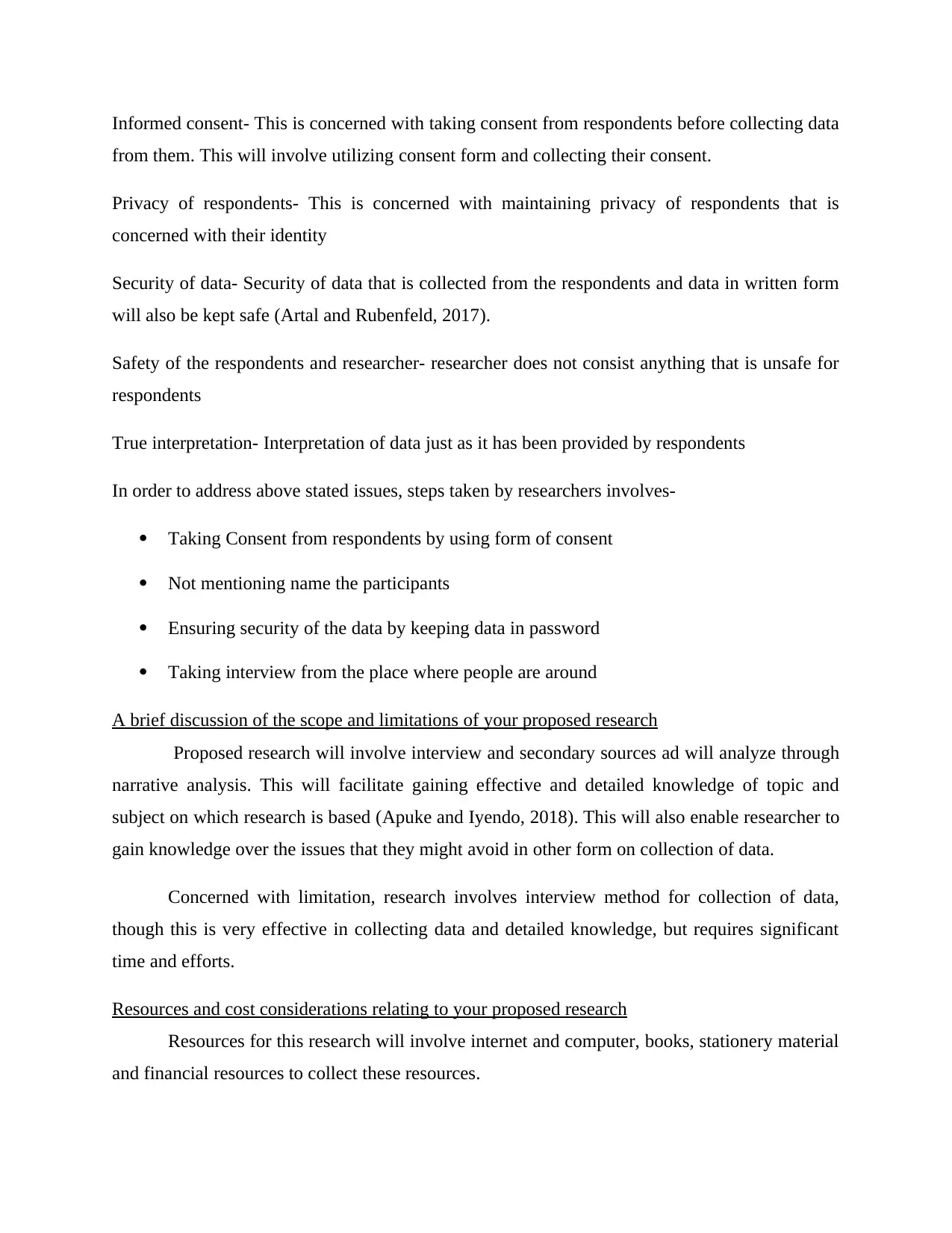
Informed consent- This is concerned with taking consent from respondents before collecting data
from them. This will involve utilizing consent form and collecting their consent.
Privacy of respondents- This is concerned with maintaining privacy of respondents that is
concerned with their identity
Security of data- Security of data that is collected from the respondents and data in written form
will also be kept safe (Artal and Rubenfeld, 2017).
Safety of the respondents and researcher- researcher does not consist anything that is unsafe for
respondents
True interpretation- Interpretation of data just as it has been provided by respondents
In order to address above stated issues, steps taken by researchers involves-
Taking Consent from respondents by using form of consent
Not mentioning name the participants
Ensuring security of the data by keeping data in password
Taking interview from the place where people are around
A brief discussion of the scope and limitations of your proposed research
Proposed research will involve interview and secondary sources ad will analyze through
narrative analysis. This will facilitate gaining effective and detailed knowledge of topic and
subject on which research is based (Apuke and Iyendo, 2018). This will also enable researcher to
gain knowledge over the issues that they might avoid in other form on collection of data.
Concerned with limitation, research involves interview method for collection of data,
though this is very effective in collecting data and detailed knowledge, but requires significant
time and efforts.
Resources and cost considerations relating to your proposed research
Resources for this research will involve internet and computer, books, stationery material
and financial resources to collect these resources.
from them. This will involve utilizing consent form and collecting their consent.
Privacy of respondents- This is concerned with maintaining privacy of respondents that is
concerned with their identity
Security of data- Security of data that is collected from the respondents and data in written form
will also be kept safe (Artal and Rubenfeld, 2017).
Safety of the respondents and researcher- researcher does not consist anything that is unsafe for
respondents
True interpretation- Interpretation of data just as it has been provided by respondents
In order to address above stated issues, steps taken by researchers involves-
Taking Consent from respondents by using form of consent
Not mentioning name the participants
Ensuring security of the data by keeping data in password
Taking interview from the place where people are around
A brief discussion of the scope and limitations of your proposed research
Proposed research will involve interview and secondary sources ad will analyze through
narrative analysis. This will facilitate gaining effective and detailed knowledge of topic and
subject on which research is based (Apuke and Iyendo, 2018). This will also enable researcher to
gain knowledge over the issues that they might avoid in other form on collection of data.
Concerned with limitation, research involves interview method for collection of data,
though this is very effective in collecting data and detailed knowledge, but requires significant
time and efforts.
Resources and cost considerations relating to your proposed research
Resources for this research will involve internet and computer, books, stationery material
and financial resources to collect these resources.
⊘ This is a preview!⊘
Do you want full access?
Subscribe today to unlock all pages.

Trusted by 1+ million students worldwide
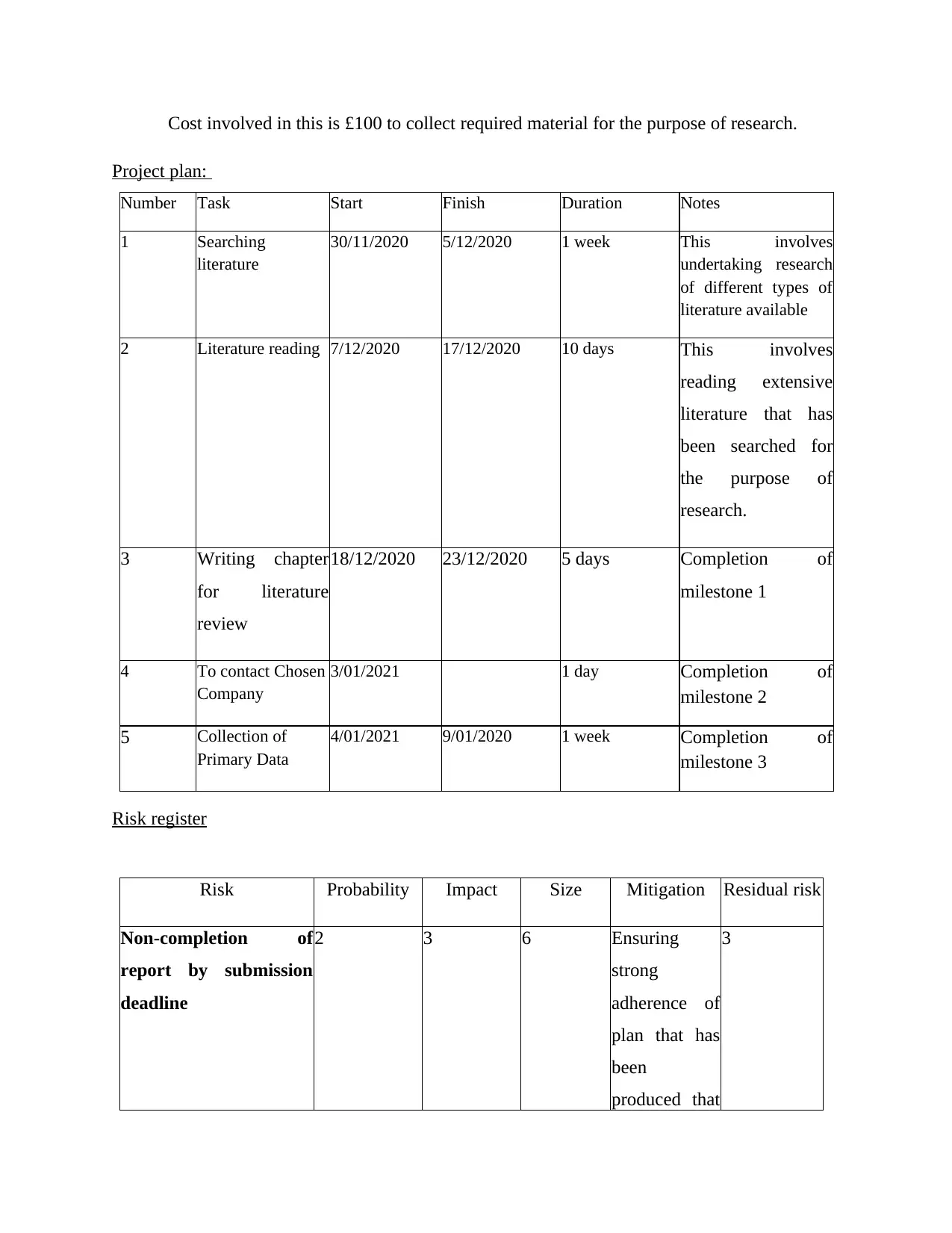
Cost involved in this is £100 to collect required material for the purpose of research.
Project plan:
Number Task Start Finish Duration Notes
1 Searching
literature
30/11/2020 5/12/2020 1 week This involves
undertaking research
of different types of
literature available
2 Literature reading 7/12/2020 17/12/2020 10 days This involves
reading extensive
literature that has
been searched for
the purpose of
research.
3 Writing chapter
for literature
review
18/12/2020 23/12/2020 5 days Completion of
milestone 1
4 To contact Chosen
Company
3/01/2021 1 day Completion of
milestone 2
5 Collection of
Primary Data
4/01/2021 9/01/2020 1 week Completion of
milestone 3
Risk register
Risk Probability Impact Size Mitigation Residual risk
Non-completion of
report by submission
deadline
2 3 6 Ensuring
strong
adherence of
plan that has
been
produced that
3
Project plan:
Number Task Start Finish Duration Notes
1 Searching
literature
30/11/2020 5/12/2020 1 week This involves
undertaking research
of different types of
literature available
2 Literature reading 7/12/2020 17/12/2020 10 days This involves
reading extensive
literature that has
been searched for
the purpose of
research.
3 Writing chapter
for literature
review
18/12/2020 23/12/2020 5 days Completion of
milestone 1
4 To contact Chosen
Company
3/01/2021 1 day Completion of
milestone 2
5 Collection of
Primary Data
4/01/2021 9/01/2020 1 week Completion of
milestone 3
Risk register
Risk Probability Impact Size Mitigation Residual risk
Non-completion of
report by submission
deadline
2 3 6 Ensuring
strong
adherence of
plan that has
been
produced that
3
Paraphrase This Document
Need a fresh take? Get an instant paraphrase of this document with our AI Paraphraser
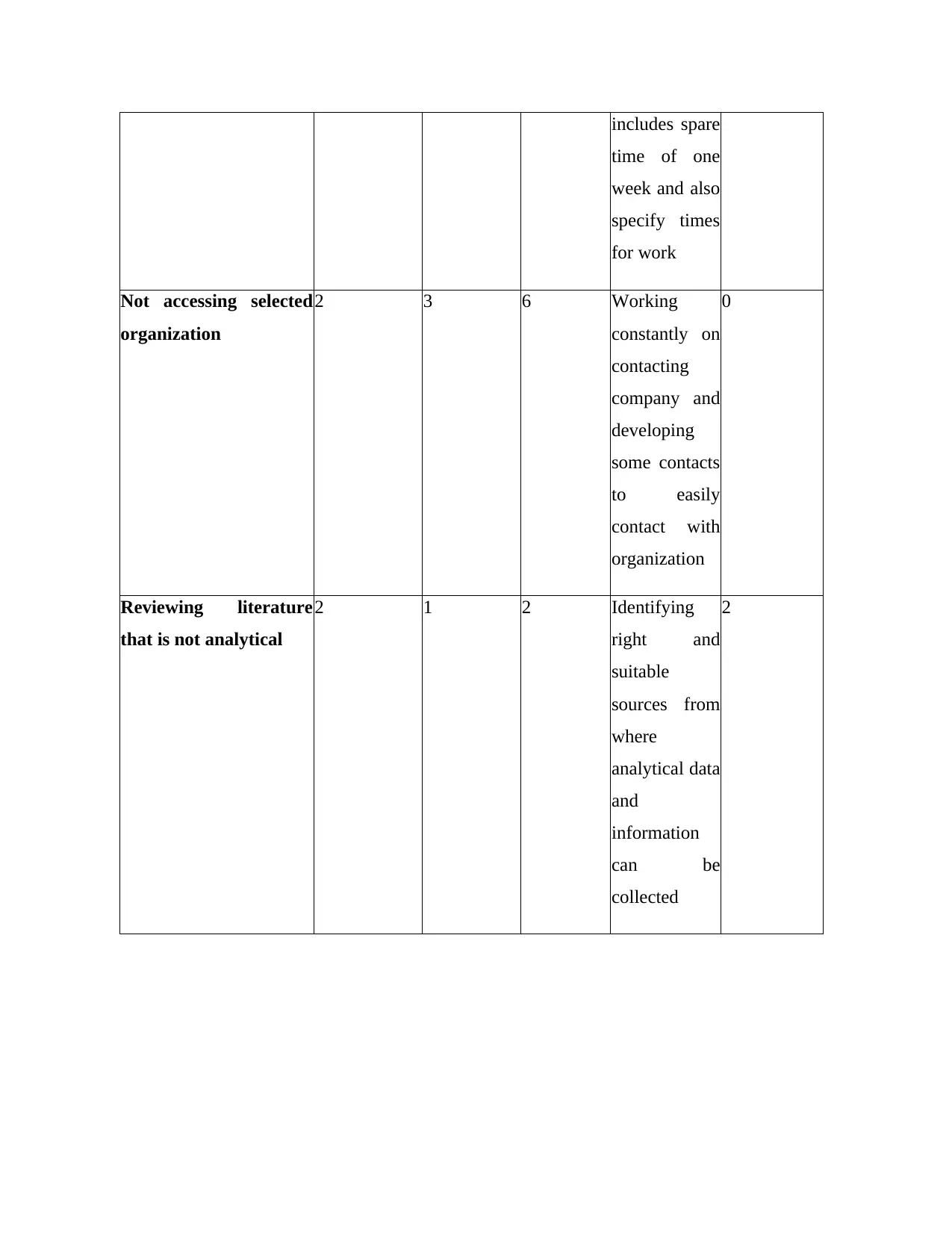
includes spare
time of one
week and also
specify times
for work
Not accessing selected
organization
2 3 6 Working
constantly on
contacting
company and
developing
some contacts
to easily
contact with
organization
0
Reviewing literature
that is not analytical
2 1 2 Identifying
right and
suitable
sources from
where
analytical data
and
information
can be
collected
2
time of one
week and also
specify times
for work
Not accessing selected
organization
2 3 6 Working
constantly on
contacting
company and
developing
some contacts
to easily
contact with
organization
0
Reviewing literature
that is not analytical
2 1 2 Identifying
right and
suitable
sources from
where
analytical data
and
information
can be
collected
2

⊘ This is a preview!⊘
Do you want full access?
Subscribe today to unlock all pages.

Trusted by 1+ million students worldwide
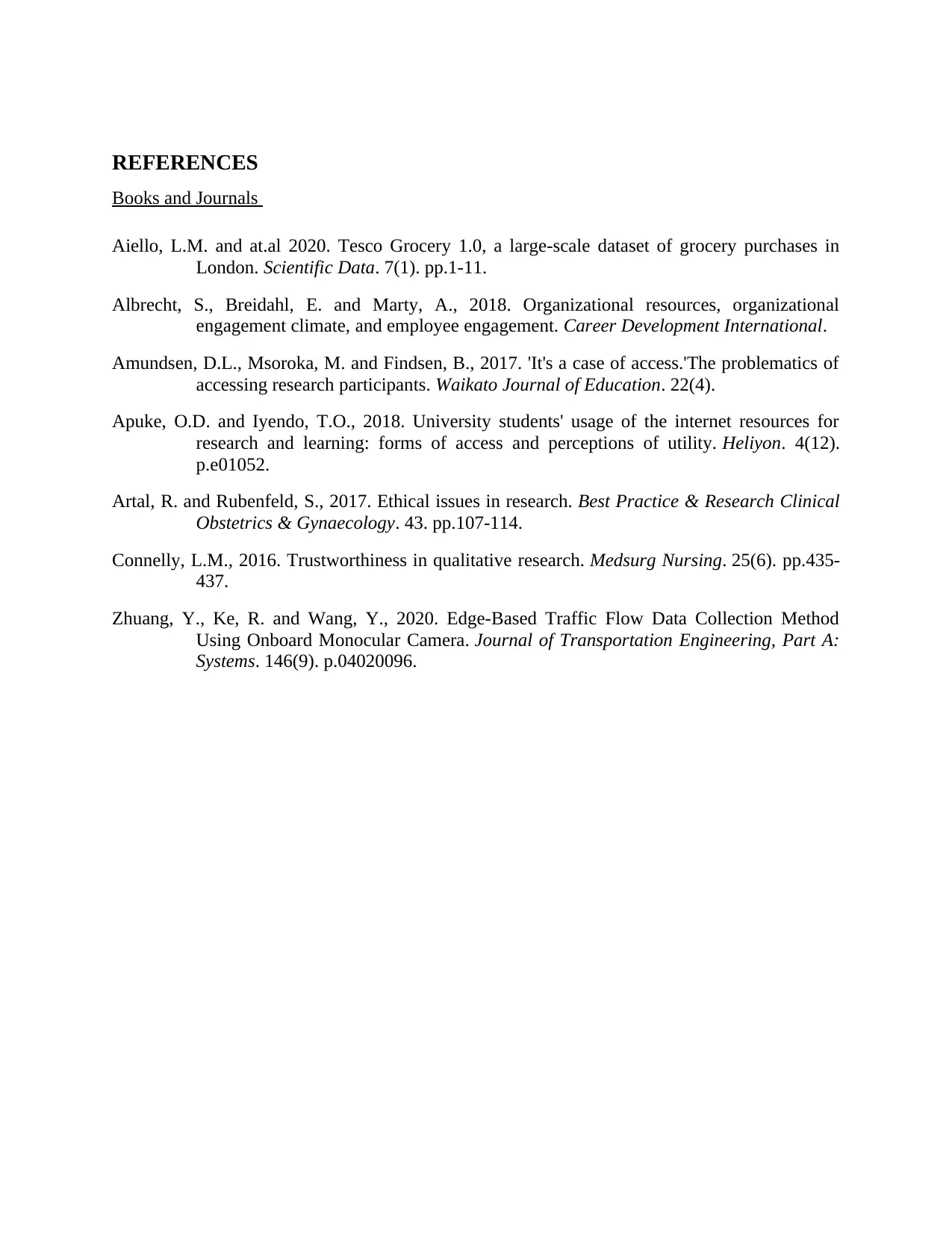
REFERENCES
Books and Journals
Aiello, L.M. and at.al 2020. Tesco Grocery 1.0, a large-scale dataset of grocery purchases in
London. Scientific Data. 7(1). pp.1-11.
Albrecht, S., Breidahl, E. and Marty, A., 2018. Organizational resources, organizational
engagement climate, and employee engagement. Career Development International.
Amundsen, D.L., Msoroka, M. and Findsen, B., 2017. 'It's a case of access.'The problematics of
accessing research participants. Waikato Journal of Education. 22(4).
Apuke, O.D. and Iyendo, T.O., 2018. University students' usage of the internet resources for
research and learning: forms of access and perceptions of utility. Heliyon. 4(12).
p.e01052.
Artal, R. and Rubenfeld, S., 2017. Ethical issues in research. Best Practice & Research Clinical
Obstetrics & Gynaecology. 43. pp.107-114.
Connelly, L.M., 2016. Trustworthiness in qualitative research. Medsurg Nursing. 25(6). pp.435-
437.
Zhuang, Y., Ke, R. and Wang, Y., 2020. Edge-Based Traffic Flow Data Collection Method
Using Onboard Monocular Camera. Journal of Transportation Engineering, Part A:
Systems. 146(9). p.04020096.
Books and Journals
Aiello, L.M. and at.al 2020. Tesco Grocery 1.0, a large-scale dataset of grocery purchases in
London. Scientific Data. 7(1). pp.1-11.
Albrecht, S., Breidahl, E. and Marty, A., 2018. Organizational resources, organizational
engagement climate, and employee engagement. Career Development International.
Amundsen, D.L., Msoroka, M. and Findsen, B., 2017. 'It's a case of access.'The problematics of
accessing research participants. Waikato Journal of Education. 22(4).
Apuke, O.D. and Iyendo, T.O., 2018. University students' usage of the internet resources for
research and learning: forms of access and perceptions of utility. Heliyon. 4(12).
p.e01052.
Artal, R. and Rubenfeld, S., 2017. Ethical issues in research. Best Practice & Research Clinical
Obstetrics & Gynaecology. 43. pp.107-114.
Connelly, L.M., 2016. Trustworthiness in qualitative research. Medsurg Nursing. 25(6). pp.435-
437.
Zhuang, Y., Ke, R. and Wang, Y., 2020. Edge-Based Traffic Flow Data Collection Method
Using Onboard Monocular Camera. Journal of Transportation Engineering, Part A:
Systems. 146(9). p.04020096.
1 out of 10
Related Documents
Your All-in-One AI-Powered Toolkit for Academic Success.
+13062052269
info@desklib.com
Available 24*7 on WhatsApp / Email
![[object Object]](/_next/static/media/star-bottom.7253800d.svg)
Unlock your academic potential
Copyright © 2020–2025 A2Z Services. All Rights Reserved. Developed and managed by ZUCOL.





